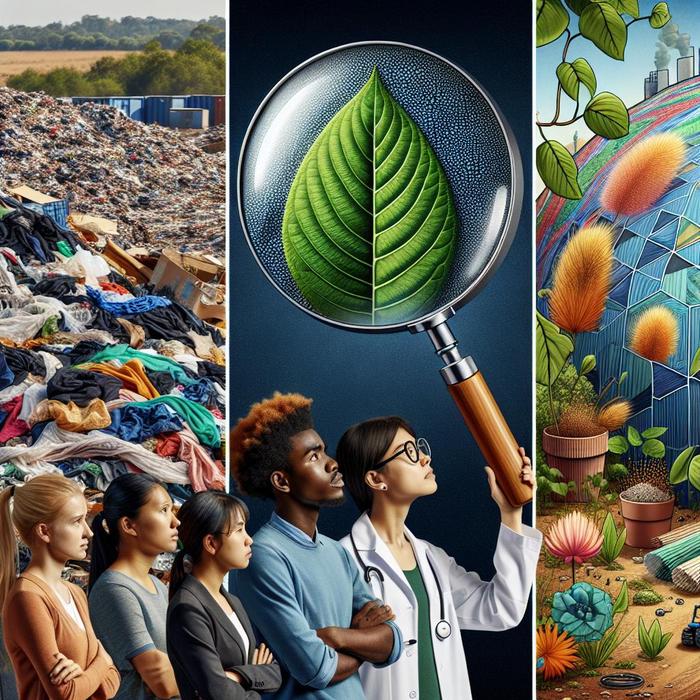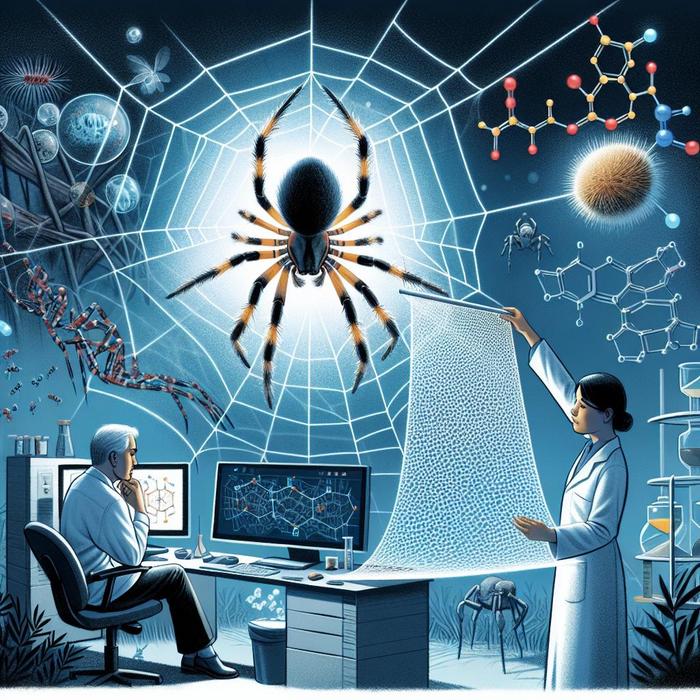Why is Textile Waste Such an Urgent Issue?
Are you aware of the enormous environmental toll that textile waste takes on our planet? The fashion industry, a significant contributor to textile waste, is notoriously recognized for its detrimental environmental effects. Fast fashion, in particular, is known for promoting a disposable culture, resulting in escalating amounts of textile waste and taking a severe toll on our planet. The materials used in these clothes are mostly non-degradable, leading to significant environmental concerns. It’s no wonder then that the search for sustainable solutions is on the rise.
So, could the solution to this crisis lie in a discipline that emulates nature’s time-tested patterns and strategies? Enter Biomimicry – a promising field that might hold the key to sustainable development in textile manufacturing.
What Makes Biomimetic Materials the Sustainable Solution We Need?
Biomimetic materials, which mimic the structures and textures found in nature, offer an exciting potential for reducing textile waste. How? By providing environmentally friendly alternatives to traditional textiles. These innovative materials borrow design elements from nature, resulting in improved durability, better waste management, and increased sustainability.
Biomimicry engineering is the cutting-edge practice of creating designs based on structures and sequences from the Earth’s natural world. Engineers collaborate with biologists to identify natural processes that are efficient and sustainable, then implement these processes into manufacturing or tool designs. Could such collaborations revolutionize the textile industry?
The Magic of Biomimicry in the Textile Industry
A huge number of innovations in the textile industry come from biomimicry, or as we like to call it, biomimeting. From spider silk inspired fabrics to dyes modeled after butterfly wings, biomimicry is making significant strides in creating sustainable textiles.
Nature reuses everything. A tree shedding its leaves doesn’t create waste – those leaves decompose and nourish the soil. Similarly, biomimetic materials encourage a shift to a circular economy where every part of the manufacturing process is reused or repurposed, reducing textile waste.
Reimagining Textile Manufacturing with Biomimicry
As we journey through the fascinating world of biomimicry, we find its potential and advantages aren’t merely limited to the creation of biomimetic materials. This remarkable concept can also revolutionize manufacturing processes, making them more energy-efficient and eco-friendly.
Biomimicry also provides a new lens to reimagine urban spaces with sustainable and efficient designs. These concepts can be applied in the textile industry for developing cost-effective and less resource-intensive production techniques.
Embracing Change with Biomimicry
Biomimicry is, at its core, a call for transformation. It’s a call for everyone, from industries to individuals, to look towards nature for solutions and to integrate these lessons into our lives.
The textile industry’s move towards adopting biomimetic materials is not just about combating textile waste. It’s about the need to transition towards a more sustainable, ecological future. It’s about acknowledging that the solutions we seek may already exist in the intricate designs of the natural world.
Biomimicry is not just a tactic or a method; it’s a mindset. And the textile industry’s journey with biomimicry is undoubtedly an engaging story for everyone invested in a greener, more sustainable future.
Discovering the Potential of Biomimicry in Medicine
The application of biomimicry extends far beyond sustainable textiles. Biomimetic technologies also play a crucial role in modern medicine, providing innovative solutions that enhance patient care and trust in the medical industry.
Breaking down the walls of traditional methodologies, biomimicry ushers in a world of sustainable alternatives that could reshape our future. It presents a compelling argument for the transformation that we all need to undergo on our path to a sustainable future. Our natural world holds the secrets to tomorrow’s sustainable technology, and all we need to do is learn to listen.
Key Takeaways: Biomimicry and Textile Waste
Biomimicry holds the promise to revolutionize the textile industry. From creating bio-inspired materials to transforming manufacturing processes, biomimicry is positioning itself as a viable solution for textile waste. It also holds the potential to steer the industry towards sustainability and efficiency, reiterating the importance of looking to nature for inspiration and solutions.
However, the adoption of biomimicry and biomimetic materials is not limited to textiles. Its applications grace various industries, offering a unique approach to problem-solving that prioritizes sustainability and efficiency, from transport solutions to medical technologies.
Are We Ready to Embrace Biomimicry?
The need for sustainable solutions has never been more critical. As the textile industry grapples with the challenge of waste, we must consider the potential of biomimicry and biomimetic materials. It’s time we turn to nature, our greatest mentor, for lessons on sustainability, efficiency, and resilience.
Are we ready to embrace the transformative potential of biomimicry? The answer lies in our willingness to learn from nature and apply those lessons in our quest for sustainable development.
How Does Biomimicry Tie into Sustainable Energy and Construction?
Have you ever imagined what it would be like to design buildings that function as naturally and efficiently as a forest ecosystem? As surprising as it may seem, biomimicry is at the heart of revolutionizing energy, construction, and infrastructure by emulating nature’s age-old strategies. A new breed of architects and engineers are cataloging design principles from the natural world and applying these to generate sustainable, forward-thinking solutions. This involves understanding how the architecture of terrestrial and marine organisms could be replicated in energy-efficient buildings.
By addressing energy usage and efficiency from a biomimicry perspective, we can significantly improve operational efficiency and reduce the environmental impact of buildings and energy systems. Harnessing the genius of nature therefore presents the next big leap forward in sustainable design and engineering.
Biomimicry: Reinventing the Wheel, or Just Going Back to our Roots?
Can we regard biomimicry as reinventing the wheel? Or is it a call to return back to our roots? A deeper appreciation of biomimicry may offer a fresh perspective on these questions. Biomimicry inherently fosters a ‘back-to-nature’ paradigm. It prompts us to move away from extractive, unsustainable practices towards holistic, accountable, and regenerative ones.
This approach can also shape our perception of technological advancement. The sophistication in technology, enhanced by biomimicry, need not necessarily mean crudely imposing our will on nature. Rather, it can signify a humble, purposeful attempt to learn from nature and co-evolve solutions aligning with the rhythms of the Earth.
Can Biomimicry Drive the Future of Robotics?
Might biomimicry enable us to envision a more harmonious blend of technology and nature? As we explore the intersection of biomimicry and robotics, it’s interesting to see where this convergence can lead us. Biomimicry offers endless possibilities to refine robotic systems, making them more efficient, more adaptable, and more closely aligned with the world they inhabit. From spider-inspired, high-precision surgical robots to robotic fish that monitor water quality, biomimicry fuels disruptive innovation in this sphere. A marriage of biomimicry and robotics presents boundless potential in various realms, from healthcare to agriculture, transportation, and beyond.
Leveraging the Power of Biomimicry for a Sustainable Food Industry
How might biomimicry transform our global food systems, ensuring food security and sustainability? By replicating the mechanisms, processes, and systems observed in nature, biomimicry can underpin sustainable strategies for food production, distribution, and consumption. It endorses closed-loop systems, nutrient cycling, energy conservation, and waste minimization, all of which are fundamental to creating a sustainable, resilient food system. From vertical farming to precision agriculture, the potential of biomimicry to reshape the food industry is immense.
The pressing environmental challenges we face compel us to rethink about industrial processes, energy usage, material choices, and waste treatment. Biomimicry raises the bar for innovation, encouraging us to transition from harmful, unsustainable practices to circular, regenerative systems that are harmonious with the planet’s ecological balance.
Exploring The Future of Biomimicry
Has biomimetic-oriented research and development reached its zenith, or are we yet to uncover its full potential? As the practical applications of biomimicry continue to engrain deeper into multiple sectors, from manufacturing to architecture, energy, transportation, and healthcare, there is no doubt that the future of biomimicry appears incredibly promising.
Europe, recognizing this potential, has launched a substantial project funding aiming to foster the use of bioinspired and biomimetic materials for sustainable textiles. Such initiatives indeed fuel the optimism that biomimicry and biomimetic engineering may help us implement the Sustainable Development Goals (SDGs) and foster a better world for future generations.
While fully espousing biomimicry may pose certain challenges, an increasing understanding and acceptance of this concept can help us transcend these hurdles. The question isn’t whether we’re ready to seize the transformative potential of biomimicry. It is how eagerly we explore this fascinating journey, imbibe the lessons of nature, and apply these to foster sustainability, efficiency, and resilience. For nature indeed encapsulates an almost infinite number of solutions we are yet to comprehend and respect.

